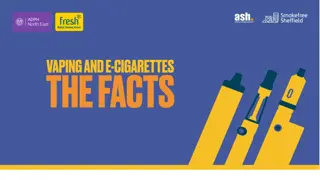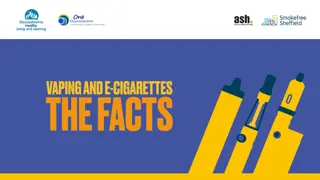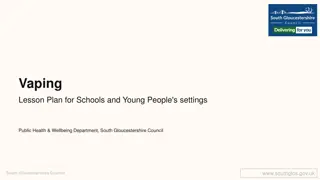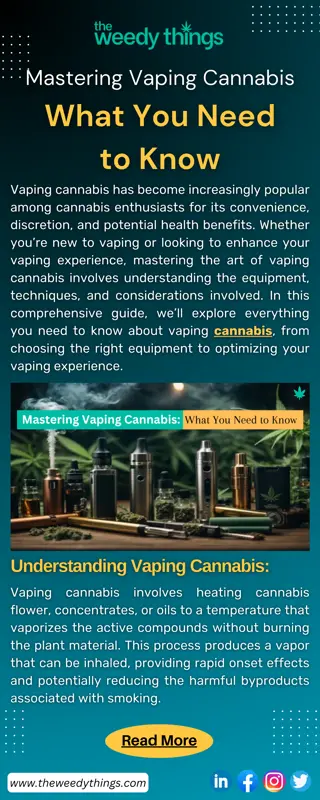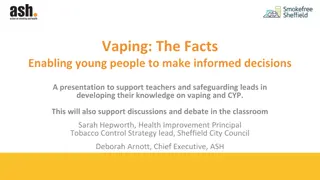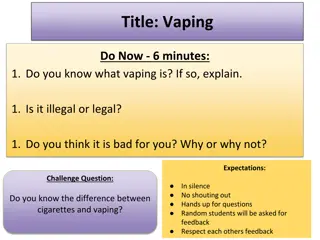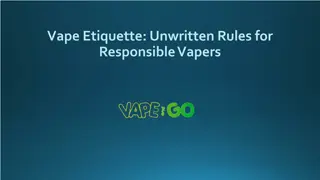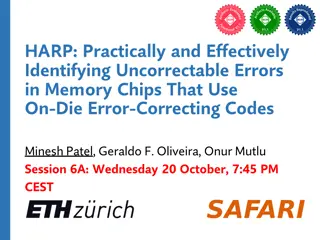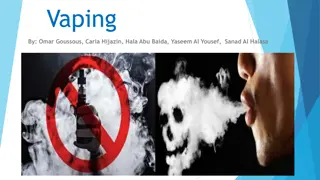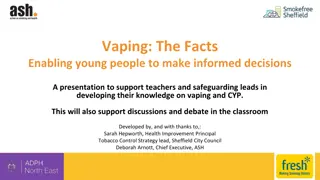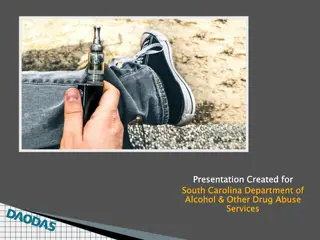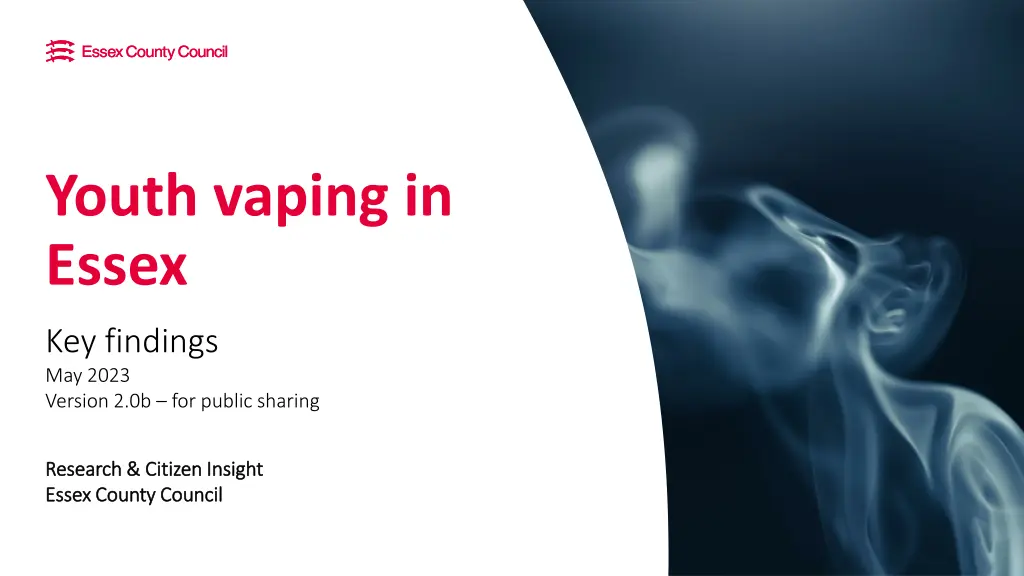
Insights on Youth Vaping in Essex
Gain valuable insights on youth vaping in Essex through a comprehensive research project conducted by Essex County Council. Discover prevalence rates, health risk perceptions, education needs, and key drivers influencing youth vaping behavior. Insights from children, young people, parents, schools, and online surveys shed light on the current landscape of youth vaping in Essex.
Download Presentation

Please find below an Image/Link to download the presentation.
The content on the website is provided AS IS for your information and personal use only. It may not be sold, licensed, or shared on other websites without obtaining consent from the author. If you encounter any issues during the download, it is possible that the publisher has removed the file from their server.
You are allowed to download the files provided on this website for personal or commercial use, subject to the condition that they are used lawfully. All files are the property of their respective owners.
The content on the website is provided AS IS for your information and personal use only. It may not be sold, licensed, or shared on other websites without obtaining consent from the author.
E N D
Presentation Transcript
Youth vaping in Essex Key findings May 2023 Version 2.0b for public sharing Research & Citizen Insight Research & Citizen Insight Essex County Council Essex County Council
Contents 1 5 Aims and methods summary Health risk perceptions and concerns Prevalence of youth vaping in Essex 2 6 Information and education Experience of vaping in Essex Regulation, monitoring and enforcement 3 7 4 8 Drivers of youth vaping Summary and next steps
This research project aims to find out about Understanding more about children & young people s (CYP s) vaping in Essex will help shape the Essex County Council Public Health Team s work, with the aim to reduce current usage and prevent uptake of vaping amongst CYP in Essex. Vaping risk perceptions, and levels of knowledge & awareness around vaping, including health impacts The culture, journey, experiences and activities around youth vaping The scale of youth vaping in Essex The messages, information or communications routes young people and parents respond best to How to change the behaviours for youth currently vaping
Sources of insight Children & Young People (CYP) Parents, carers and guardians Schools Online survey of CYP aged 11-18 years. 3,143 responses. Live December 2022 March 2023. Promoted via media and a range of partners, including Youth Services and schools. Essex-wide responses, with over- representation from Maldon, Epping Forest and Castle Point, and under- representation from Tendring. Online survey of parents / carers / guardians of 11 to 18 year olds. 882 responses. Live December 2022 March 2023. Promoted via media and a range of partners, including schools. Essex-wide responses, with over- representation from Maldon and Brentwood, and under-representation from Tendring, Rochford and Uttlesford. Live Slido poll (online survey) of 22 RSHE* leads from Essex secondary schools. Carried out at a single ASHE* RSHE meeting in November/December 2022. Key topics: Prevalence of vaping, concerns, teaching and training needs about vaping. Please note: limited sample *RSHE - Relationship, sex and health education *ASHE Association of Secondary Heads Education This report brings together the insights from across these three sources.
Overall summary 10% of CYP surveyed are regular vapers Health implications of youth vaping is a concern The majority of CYP do not vape. Yet, the amount of regular vapers (more than once a week) is above national figures (ASH 2022). Far more so for parents and schools than children and young people. Vaping is not a hidden behaviour Schools and parents are vital sources of information for CYP Young people, parents and schools are all aware of it, and vapes are seen as fairly easy to get hold of. It is seen as becoming an increasingly popular behaviour in CYP. Otherwise they turn to online sources. Yet, parental knowledge and school teaching around vaping is felt to be limited. There is a need for education overall, with schools playing a key role. Curiosity and dealing with stress and anxiety are key drivers of youth vaping Regulation, monitoring and enforcement are seen as key to address youth vaping In addition, the attractiveness of the vapes (such as the flavours and colours), enjoyment and peer pressure can encourage CYP to start vaping. Parents call for stronger industry regulation, monitoring around youth vaping, enforcement and consequences for underage vapers and suppliers, and stricter schools.
Prevalence of youth vaping in Essex
Scale of youth vaping in Essex The majority of CYP in Essex do not vape. Yet, just under a quarter of CYP in Essex engage in vaping habits, whether as an experiment, occasionally or as regular vapers. CYP vaping types and their representation in the survey (11-18 year olds) 10% Experimental vapers (only tried once or twice): Curious enough to have tried vaping. 10% Regulars vapers: Vape more than once a week, and so do their social circles. They have mostly been vaping for one year or more. 68% Never vapers Have never vaped and their friends do not tend to engage in this activity either. Yet, they are aware of vaping happening around them. Majority of survey respondents are never vapers. 3% Ex- vaper 4% Occasional vaper (less than once a week) (quit vaping) Base: 3143 Ever vapers
Scale of youth vaping in Essex 9% of 11-17 year old CYP surveyed in Essex vape regularly - three times more than nationally (ASH, 2022)*. This may be due to a general increase in popularity and sales promotions of vapes since 2022. Most young people do not vape. Similarly, most parents believe their child does not vape. Yet, for those that do, parents believed it was regularly (either every day or more than once a week). CYP experience of vaping - Essex 2023 vs. ASH 2022 (ages 11-17) 69% Never vaper (never tried) Of parents surveyed said their child doesn t vape or they didn t think so. 80% Base=882 84% 10% Experimantal vaper (only tried once or twice) 8% Of parents surveyed said their child vapes or they thought so. 19% Base=882 4% Occassional vaper (less than once a week) 4% Parents of vapers: How often do you think your child vapes? 6% vape every day 9% 50% Regular vaper (more than once a week) 3% 39% 40% 3% 30% 25% Ex-vaper (quit vaping) 1% 20% 13% 13% 6% 10% 5% Base: 3060 Essex 2023 ASH 2022 0% Sometimes, no more than once a month Only tried once or twice Don t know More than once a month, but less than once a week More than once a week, but not every day Every day *ASH 2022 survey is based on 11-17 year olds. For direct comparison purposes with ASH 2022, Essex figures have been recalculated to include only 11-17 year olds (this chart only all remaining analysis is based on 11-18 year olds). Please note differences in survey methodology may impact direct comparability. Base: 161
Exposure to vaping Young people are aware of others their age vaping. Exposure is mainly at school, through their friends or family members While most parents said that they or other adults in their household do not vape and never had, and believe that exposure to friends vaping is a motivator for CYP. 64% of CYP know at least 1 in 10 other CYP that vape. Parents: Do you or any other adults in your household vape? 100% 25% of CYP believe at least 50% or more of the young people they know vape 81% 80% 60% 40% CYP: Do any of these people that you know vape? 16% 20% Base: 879 Students at my school 55% 4% 0% My friends 34% No, and never have Yes Used to No, none of the people I know vape 23% Of parents surveyed believed their child is more likely to vape if the child s friends vape 64% Base=842 Other relatives 22% 37% are exposed family members / relatives My mother, father or guardian 18% My brother or sister 15% 95% of parents thought youth vaping is becoming increasingly popular. Many commented that they see and hear about it more, and even smell it more (base = 842). My boyfriend or girlfriend 6% Base: 3099 Other 1%
Experience of youth vaping in Essex Types of vapers
Never vapers: curiosity and likelihood to try The Never vaper 100% 1% 2% 4% 90% 13% 18% 80% 68% Of CYP surveyed claim to have never vaped before 70% 15% This group appear to be adamant non-vapers. Majority are not curious about vaping, and are even less likely to try vaping if someone offered it to them. 60% Younger aged CYP are more likely to be never vapers . Numbers of never vapers decrease as age increases. 50% 40% 73% Never vapers: I have never tried vaping, not even a puff or two (as a proportion of respondents per each age group) 30% 60% 100% 20% 88% 87% 78% 80% 70% 10% 59% 60% 46% 40% 0% 32% 25% Have you ever been curious about vaping? If someone you know offered you a vape, would you try it? 20% Definitely not Probably not Probably yes Definitely yes 0% 11 years 12 years 13 years 14 years 15 years 16 years 17 years 18 years Base: 2083 (curious) and 2080 (offered) Don t knows are not shown on the charts but remain in the population base sizes Base: 2122
The Experimental vaper Experimental vaper: How old were you when you tried vaping? 25% 19% 18% 20% 17% 10% 15% Of CYP surveyed claim to have only vaped once or twice 13% 11% 10% 10% 5% 5% CYP are more likely to give vaping a try as they get older, with this being the main reason why experimental vapers start. Over half of experimental vapers first tried vaping between the ages of 13 and 15 years. 3% 2% 1% 0% 10 years and younger 11 years 12 years 13 years 14 years 15 years 16 years 17 years 18 years Don t want to say Friends are the main source of obtaining vapes. Base: 276 I m very worried about how it will affect me and how to keep up boundaries about it. Despite me only trying it once, it s tempting to try it again because my family and friends smoke a lot. I don't want to try it again because it felt horrible and the nicotine rush gets to me badly and I don't wanna get addicted to nicotine or tobacco like my family did. Also I usually find vapes and boxes everywhere I go. So it really does not help the temptation. Experimental vapers: I have only tried vaping once or twice (as a proportion of respondents per each age group) 19% 20% 18% 15% 13% 12% 10% 10% 8% 6% 6% I only did it like four times because of peer pressure from a friend. 5% 0% 11 years 12 years 13 years 14 years 15 years 16 years 17 years 18 years Base: 318
The Regular vaper Regular vaper: How old were you when you started vaping? 20% 18% 16% 16% 15% 15% 11% 10% 10% Of CYP surveyed claim to vape regularly (at least once a week) 9% 10% 5% 3% Older CYP are more likely to vape regularly, particularly aged 15+. 58% of regular vapers surveyed have vaped for more than a year, with further 17% having been vaping for between 6 months and a year. Two thirds have started vaping between the ages of 12 and 15 years. 1% 1% 0% 10 years and younger 11 years 12 years 13 years 14 years 15 years 16 years 17 years 18 years Don t want to say Base: 278 This suggests that vaping behaviour is embedded, and CYP may need more support to quit, should they want to. Regular vaper (as a proportion of respondents per each age group) It becomes very addictive and hard to stop, it s like that one thing you rely on. 35% 30% 29% 30% 25% 20% I think it just helps people with their worries. Like my friend s, I know she vapes so it calms her down so I just think it helps many people with worries, concerns and stuff. 20% 15% 12% 10% 7% 4% 5% 2% 1% 0% 11 years 12 years 13 years 14 years 15 years 16 years 17 years 18 years Base: 299 -5%
Frequency of vaping increases with age The distribution of vaping types across CYP age groups demonstrates the key ages for CYP to start experimenting with vaping would be late KS3 (Year 7- 9; 11-14 years) , with the risk of vaping becoming a common behaviour increasing at KS4 (Year 10-11; 14-16 years). Types of vapers (as a proportion of respondents per each age group) 100% KS4: vaping behaviour is likely to become more embedded 90% 80% 70% This aligns with feedback from RSHE leads, who observed prevalence of vaping in KS3 as moderate , and KS4 as high or very high . 60% Late KS3: vaping experimentation more likely to begin 50% 40% 30% 20% This demonstrates the importance of evolving approaches to prevent and stop vaping behaviour in CYP at different stages. For example, preventative strategies for the younger age groups, shifting to initiatives that may focus more on how to either resist temptation / peer pressure or how to quit services for older CYP. 10% 0% 11 years 12 years 13 years 14 years 15 years 16 years 17 years 18 years Never vaper 87.6% 86.6% 78.0% 70.0% 59.0% 45.6% 31.5% 25.3% Experimental vaper 5.7% 6.2% 8.1% 10.3% 12.1% 13.0% 18.7% 18.1% Occassional vaper 0.6% 1.1% 2.1% 3.8% 5.4% 8.8% 11.3% 10.8% Regular vaper 1.8% 1.4% 4.3% 7.0% 11.9% 20.1% 28.6% 30.1% Ex-vaper 0.3% 0.7% 1.7% 2.8% 3.4% 5.1% 5.9% 12.0% Don t knows are not shown on the charts but remain in the population base sizes
Drivers of youth vaping Reasons for vaping Promotion Accessibility
Drivers of vaping: CYP Curiosity, mental health, the experience and flavour of the vapes, social influences and addiction are the main reasons for vaping. CYP: Which best describes why you vape? Just to give it a try 43% It helps me deal with stress or anxiety 34% I like the flavours 33% These reasons reflect the national findings from the ASH (2022) survey, and are primarily focused around social and psychological motivators vs. pure opportunity. I enjoy the experience 23% Peer pressure 14% I am addicted to them 14% For example, over a third of Essex youth vapers stated that vaping helps them to deal with stress and anxiety, not featured in the ASH survey. Vaping is easier to hide than smoking 10% Vaping may be less harmful to me 8% I think vaping looks cool 8% They are cheaper than smoking 8% Young people told us: They are easier to get hold of than 7% I think the main reason the people vape is because of peer pressure and anxiety etc. Don't know 7% I use them instead of smoking 7% I want to stop, but I really enjoy the nicotine rush I get and I like the flavours and it just helps with my GCSE and stress. Base: 750 NB: multi-select so won t add to 100% I use them in addition to smoking 5% Other 2% The advertisements, such as the flavours and colours, are clearly marketed towards people my age and younger, so I have seen 12 year olds vaping too. 0% 10% 20% 30% 40% 50%
Drivers of vaping: Parents view Parents: Please describe why you believe youth vaping is becoming increasingly popular 29% I see youth vaping e.g. in public 26% Image - appear cool, it's trendy, fashionable, or rebellious 22% Wide availability and easy access Similar to CYP views, parents note the attractiveness of vapes, and social influences such as peer pressure, could be driving vape popularity. 19% Attractiveness & advertisement/marketing of vapes 13% Unknown or lack of perceived health risks, or safer than smoking 12% Social influences; other people, peer pressure and social media Additionally, many parents believed popularity is being driven by: 12% Believe it's more common, a trend, increasing generally Personal image vaping to look cool or older, it being fashionable or trendy to vape, or to be anti-authority and rebellious. 11% Hearing about youth vaping 7% Aware of, believe or know CYP that vape 4% Alternative to/replaced smoking Accessibility and availability vapes are widely available, and easy to access even for the underaged. 4% Discreetness of vapes 4% Social acceptability & normalisation Unknown, or lack of perceived health risks - CYP are less aware of risks, or they believe vapes are safe or harmless. Advertisement and attractiveness contribute to this perception. 2% Addiction 1% Parents don t care about child vaping/ecourage/supply it 1% Seeing vape litter in public 1% Some worry that that vaping has replaced smoking, yet does not carry a stigma like smoking; it has become normalised and acceptable to vape, and can be used in many locations. Don t know 0% CYP unsupervised/have nothing to do/are bored 0% Mental health - coping, dealing with stress or anxiety 0% 10% 20% 30% Base: 745 NB: can describe multiple themes, so won t add to 100%
What parents said about why youth vaping is increasingly popular: They are deliberately targeting young people with brightly coloured, small pocket sized vapes in sweet flavours. It does not come with the same lingering smell of cigarettes so they don t get caught as easily. They are like sweets to children. Seen as an acceptable and safe form of smoking and like smoking, kids see it as cool, trendy, anti authority. This is due to the packaging of the product. The variety of colours and designs, the emphasis on flavours, that are now sweet flavours like Skittles or fruit flavours like strawberry flavour, making it sound healthy and not harmful. It s seen as less harmful than smoking and therefore all our children think it's OK to do, after all we aren't smoking are we ? Kids think it's not of a very high risk due to the fun element of flavours, colours, accessibility and throw away culture of the cases / pens. Anything that tastes like a Strawberry Chewits and not a Benson & Hedges will be attractive to an impressionable teenager. It's easy to get hold of, peers are doing it so copying to fit in. No awareness of how dangerous it is so think it's harmless to do. Looks trendy and colourful; easily accessible; relatively cheap; children do not perceive any health risks; friendly flavours make the products seem like sweets. Many children have gone from a non smoking family, from primary school to high school and now vape because it s seen to be cool. They've never smoked. Readily available. Undetectable to smoke detectors. Fashion. Peer pressure. It s a trend, children that have never smoked a cigarette before are vaping because of the flavour, if all your friends in your circle are vaping around you and encourage you to have a go then you get addicted to having the flavoured smoke. It s become a fashion accessory like Nike trainers. You can see plenty of children on the streets vaping.
Vaping promotion is common CYP are not only exposed to vaping through social circles. Shops and social media are the most frequent channels contributing to awareness of vapes. CYP: 'In which, if any, of the following places do you ever see vapes being promoted?' In shops 61% Social media 49% This is followed by websites and public transport. Websites 23% This reflects ASH (2022) survey results, which listed shops (46.5% ever vapers, 34.8% never vapers) and online (35.8% ever vapers, 21.7% never vapers) as the main sources of exposure. On public transport other than buses 15% On buses 14% On TV 14% Yet, levels of exposure appear considerably higher in Essex vs. national picture. I don't see vapes being promoted 13% Don't know 13% Parents noted a concern of the role of social media and the glamorisation of vapes as a key social influence driving increasing CYP vape use. Billboards 11% In newspapers/ magazines 10% Somewhere else (other) 2% 0% 20% 40% 60% 80% It s not promoted by any of these things really. Like many not so major issues around people of our age, things become an obsession because other people our age do it and everyone just wants to fit in. If I look on any person in my year s Instagram page, the chances are they ll have some picture of them with a vape in hand. More people see others doing this and just want to be like them. (CYP) Base: 3138 * In the Essex survey, promotion was defined as something that tries to increase interest in, or demand for, vapes, including the use of vapes by social media influencers .
TikTok is a key social media channel promoting vaping CYP: Location of social media vaping promotion seen 80% 72% Base: 1536 70% 60% 46% 50% TikTok is the main social media platform where imagery and messaging around vaping is seen by CYP. Instagram and Snapchat followed. 42% 40% 29% 30% 18% 16% 20% 14% While this reflects the ASH (2022) survey in terms of popularity of channel, Essex survey reports considerably higher levels of exposure via these individual platforms, especially in terms of TikTok. 10% 2% 0% TikTok Instagram Snapchat YouTube Twitter Facebook Other Don't remember CYP: Location of social media vaping promotion seen Essex 2023 (11-18 year olds) vs. ASH 2022 (11-17 year olds) It is possible that the popularity and use of TikTok in general has increased since 2022. 72% 80% 70% TikTok, but it s not direct promotion, just unintentional influencing. (CYP) 46% 60% 45% 42% 50% 31% 29% 27% 40% 22% When I see it being promoted on TikTok, it is usually in the form of mockery. (CYP) 18% 16% 30% 15% 14% 13% 20% 6% 2% 10% It seems to be a cool accessory for social media and groups of teenagers. (Parent) 0% TikTok Instagram Snapchat YouTube Twitter Facebook Other Don't remember Essex 2023 (11-18 yo) ASH 2022 (11-17 yo) They can see it on social media where they make it cool. (Parent)
CYP ever vapers: 'Where did you get your first vape from?' Vapes are easily accessed Given by a friend 44% Bought it in a shop 14% Can't remember / don't want to say 11% Took it from someone 7% Young people do not struggle to access vapes. Friends and direct purchasing from small shops are the two main sources. Bought it from another person 7% Given by a brother or sister 5% Bought it online 3% Base: 745 Other way 8% 44% of ever vapers were given their first vape by a friend; while 14% bought it in a shop. 0% 5% 10% 15% 20% 25% 30% 35% 40% 45% 50% CYP ever vapers: 'Where do you usually get your vapes from?' For the most part, young people then continue to get vapes from friends, with 24% getting vapes from newsagents, tobacconists, vape shops or sweet shops. Friends give them to me 37% Newsagent, tobacconist, vape shop or a 24% Don't want to say 16% Someone else gives them to me 15% I buy them from friends 11% 82% of parents agree that children can get access to vapes very easily (base = 841). Other type of shop 11% My brother or sister gives them to me 8% Street markets 8% Shop purchasing is a concern for parents and RSHE leads. Internet 8% Parents often viewing the ease of obtaining vapes from friends, other people or shops as a key driver of increasing popularity of youth vaping. Petrol station or garage shop 7% I get them in some other way 6% Supermarket 6% I buy them from someone at school (not 6% All RSHE leads (n=15) have concerns about local retailers providing vapes to students from their schools. My mother or father (or guardian) gives 5% Base: 716 Machine 2% 0% 10% 20% 30% 40%
CYP ever vapers: 'In the past 12 months, did any of the following apply to you?' - Accessibility of vapes Shops sell vapes to under 18s I bought a vape (or cartridge, pod, eliquid) from a shop 48 42 10 I was refused sale of a vape from a shop 56 22 22 Young people below the age of 18 have a high chance of being able to buy vapes directly from shops. Someone else bought me a vape from a shop 46 40 14 In the last 12 months: 0% 10% 20% 30% 40% 50% 60% 70% 80% 90% 100% No Yes Don't want to say/N/a 42% of ever vapers bought a vape directly from a shop: Base: 744, 741 and 744 From these, 91% were aged 11-17; i.e. vapes were sold to them illegally. 2 out of 3 were regular vapers (mostly vaping every day), aged 14 and 17 years. Young people told us: I believe there should be tighter restrictions on being able to get a vape. But this would have to be directly mostly as off license shops which I frequently hear my friends discussing, as there is an alarming amount which will serve teenagers vapes, cigarettes and alcohol, all without asking for an ID. 56% of ever vapers were not refused a sale from a shop: From these, 92% were aged 11-17; i.e. sales proceeded illegally. 40% were experimental vapers and a third were regular vapers. 40% of ever vapers had someone else buy them a vape from a shop: I think that too many young people are doing it and that vape shops should be shut down and shops that sell them should be told not to give anyone under the age of 21 a vape and they need to show ID for proof. Some people may buy them for people under age which I also think is bad and needs to stop. From these, 95% were aged 11-17. 2 out of 3 were regular vapers (mostly vaping every day), aged 14 to 17 years.
Accessibility of vapes Young people told us: Parents told us: Underage kids at my school buy them and give them out to people. Apparently some shops are willing to give them vapes even though it s illegal as they are underage. They can easily be purchased. There seems very little asking for ID and they can buy them from friends in school so easy. So many children can get vapes especially in shops in and around town!! My daughter has been served many times by a shop by the bus station!! She s 14. Too many children vape and unfortunately think it s cool. Everyone under 18 basically buy them from shops by editing their ID on an app. Too many young people do it. It spreads round schools like a virus and people turn it into a business by selling them to younger students. I've heard of parents buying them for their children to sell to their friends at school. The majority of underage people in this area get their vapes from an older sibling/friend or my friends have told me about dodgy off licences that sell vapes to minors. See a lot of youths in our area using vapes. We even have a group of teenage boys that sell vapes and are well known for it in the area. It seems to be promoted everywhere as a cool thing to do, I do not think so, but almost everyone I know, not immediate family, smoke or vape, especially at school. I think that people selling vapes to those underage should be policed more heavily. You see more and more of them vaping now especially as the disposable ones are easy to buy. Very accessible to young people - IDs are hardly asked for. Widely promoted and considered the norm . None of the health risks are highlighted when buying them. Advertising is extremely targeted at younger people with bright colours and extravagant flavours. It's easily accessible, kids are selling it to each other and passing them round in high school.
Health risk perceptions and concerns
Widespread concern over youth vaping Parents and schools are very aware and concerned about the popularity of youth vaping. Most parents believe there may be negative health consequences that arise from vape use, with some uncertainty around harmfulness of vaping vs. smoking. Parents: How do you/would you feel about your child vaping? Parents: "I believe that..." 100% 83% "Vapes are less harmful than smoking traditional cigarettes for my children" 80% 65% 14% 55% 13% 18% 60% 40% 30% Children who use vapes may develop negative health consequences 15% 20% 4% 4% 3% 88% 4% 2% 1% 0% 0% Extremely worried Somewhat worried Not at all worried I don t know Agree Neither disagree nor agree Disagree Don't know How do you feel about your child vaping? (believes child vapes, base = 161) How would you feel if your child started vaping? (believes child doesn t vape or doesn t know, base = 690) Of RSHE leads surveyed said they were somewhat (41%) or extremely (59%) worried about students vaping on school property or at school events. Level of concern over health consequences are consistent for parents where they believe their child already vapes and those who do not believe their child vapes. 100% Base=17
Unknown and harmful consequences of vaping - driver of concern for parents They have unknown ingredients, are aimed at children (sweet, sugary childish flavours), and is a gateway to cigarette smoking and cannabis smoking. They are full of harmful chemicals that are inhaled directly into the lungs, there's no way that this won't cause long term damage. Q: Please describe what your beliefs are around the safety for children to use vapes 60% of parents (base = 725) described vapes as unsafe, risky, harmful or dangerous . Concerns included the inhalation of substances and chemicals, and their addictive properties. There is not enough known about what is in vapes and what effect they have on young developing children. Unknown effects and vaping can lead to nicotine addiction which they didn't have before (as most children are not vaping to give up smoking, it is just the in thing to do). 23% of parents cited unknown health effects, limited research , especially in terms of the long-term effects. Don t think it s as bad as smoking but still not good for you. 7% of parents also thought that vaping could be as bad or worse than smoking. 3% thought it may be a gateway to smoking or other substance misuse. I have no real knowledge, but consider vaping as dangerous as smoking cigarettes, if not more so as children think it is safe. No real evidence yet about the dangers, but still putting toxins in your body. Few parents viewed vaping as a safer alternative to smoking (3%). Few (2%) also thought vaping was harmless.
CYP vapers show less concern for their health CYP: Compared to cigarettes, do you think vapes are more or less harmful to the person using them, or is there no difference? 50% 41% 40% 29% 30% Young vapers are not as concerned about the potential health risks of vaping as adults. 17% 20% 13% 10% 0% Though there is some awareness around the risks of vaping being similar to smoking, 29% viewed vapes as less harmful than cigarettes*. Less harmful About the same More harmful Don't know Base: 3119 Few young vapers, particularly regular vapers, were concerned about the future risks of vaping on their health. CYP ever vapers: 'Are you worried that vaping will damage your health in the future?' 50% This is reflected in the behaviour around nicotine usage, which is high amongst all CYP that vape: 40% 35% 33% 40% 30% 1 in 2 using nicotine vapes all the time. 30% 16% 14% 20% 11% 1 in 4 sometimes using vapes containing nicotine. 9% 8% 6% 10% 0% Very worried Moderately worried A little worried Not at all worried Don t know * Please note that this could be viewed as in line with NHS guidance: Vaping is not completely risk-free, but it poses a small fraction of the risk of smoking cigarettes (NHS, 2023) Regular vaper Experimental and occasional vapers, ex-vapers Base: Regular vaper: 277; the rest: 469
Health risks seem to work as a deterrent for non-vapers and ex-vapers Young people told us: There needs to be more info on vapes and the danger so people don t smoke them, at the moment they just look in a way like grown up sweets. 3% of CYP surveyed stated they used to vape. Reasons for stopping vaping include: People don t realise the harm of vapes I feel due to the lack of evidence or opposing evidence. It is likely in the future vapes will be a prominent cause of lung disease and infection. There needs to be more negative attention toward the impact of vapes on lung health. 44% concerned about possible health risks or side effects 40%lost interest/didn t enjoy it 35% concerned about addiction to vaping My friends make fun of me for not vaping, but I think vaping is dangerous so I don t do it. This is reflected in the verbatim comments received from CYP (base 398) where many had not previously tried vaping: Although I believe individual puffs compared to cigarettes may be less harmful, the people who vape have a lot more puffs as they sit there for ages just taking puffs as well as it s flavoured so I believe it is easier to go for longer. 34% mentioned vaping being bad or dangerous 13% gave specific examples of potential negative health impacts 8% compared vaping with the use of cigarettes Vapes might be worse in long term, we just don t know. This is what happened with cigarettes. They said they were healthy, turns out they are death sticks. Might be the same with vapes, we just don t know yet. 7% discussed the lack of research into the effects of vaping 6% felt there was a need for more regulation and legal status of vaping.
CYP occasional, regular and ex-smokers: Which one did you try first? Base: 188 (no responses from those who had only tried smoking once or twice) 3%3% Vaping vs. smoking Smoking Vaping Don't want to say 38% Don't remember 56% Of CYP surveyed had never smoked regular cigarettes 85% Have only tried cigarettes once or twice 7% CYP occasional, regular and ex-smokers: Age at which had first cigarette Smoke regularly (at least once a week) 3% 19% (The rest are occasional or ex-smokers) 20% 16% 15% 14% 13% 15% 11% 10% 6% 4% 38% of current and ex-smokers had tried a vape first. This indicates that for some, vaping may act as a gateway into smoking - a concern reflected in 2.5% of parents. 5% 2% 1% 0% 10 years and younger 11 years 12 years 13 years 14 years 15 years 16 years 17 years 18 years Don t want to say Base 191 CYP occasional, regular and ex-smokers: Views on how addictive vaping is compared to regular tobacco cigarettes Most current and ex-smokers had their first cigarette at age 16 and below, with peaks at 13 years and 10 years or younger. 38% of those smoking every day started at 10 years or younger (base = 42). 40% 32% 28% 30% 20% 15% 9% The general view is that vapes are more, or as addictive as cigarettes. Almost a third felt that vapes are a lot more addictive than cigarettes . 8% 8% 10% 0% A lot more addictive than cigarettes A little more addictive than cigarettes As addictive as cigarettes A little less addictive than cigarettes A lot less addictive than cigarettes Don t know Base 191
Information and Education Current levels of knowledge Role of parents Role of schools
CYP: In the last 12 months, have you looked for / come across any information about the health risks of vaping? CYP look to parents and schools for health risk information Don t know 17% Yes 43% Information gaps may be filled by social media or friends, where there is a risk of drawing their own conclusions based on the largely uncontrolled content they come across. No 40% CYP: Sources of information about health risks of vaping My school spoke to us (e.g. in a class setting) about the health risks 63% Almost the same proportion of young people have either encountered, or not encountered, information about the health risks of vaping (around 40% each). The rest did not know. My parents/carers and I spoke about the health risks 34% I looked up information about the health risks on the internet 24% Other mentions = social media (generally), followed by TikTok. My friends and I spoke about the health risks 20% For those who had, the main source of information was the school, followed by their parents/carers. Other 7% I have looked for information but I could not find anything useful / reliable 6% This aligns with the finding that 83% of parents said they have tried talking to their child about vaping. (base = 822) 0% 20% 40% 60% 80% I think that I should have been taught about it at a younger age and been told the risk before I started. (CYP regular vaper) Around proactively looked on the internet, with social media being an additional source of information Why does the NHS promote it? How do I help someone stop vaping?
Parents: How would you rate your general knowledge and awareness around vaping? Parental knowledge around vaping could be improved 45% 50% 40% 34% 30% While most parents are comfortable having a conversation with their child about vaping, their actual knowledge about vaping appears more limited. 20% 9% 8% 10% 2% 1% 0% Excellent Good Average Poor Very poor Don't know Base: 828 94% of parents feel comfortable having a conversation about vaping with their child. Parents: Please rate how much you agree or disagree with the following statements 100% 2% 3% 12% 90% However, only 73% of parents agreed they felt confident they knew enough about vaping to have a conversation with their child. 80% 14% Don't know 70% 60% Disagree 50% 94% Further, 45% of parents rated their general knowledge and awareness around vaping as average . 43% rated it as good or excellent , and 11% as poor or very poor . Neither disagree nor agree 40% 73% 30% Agree 20% 10% 0% "I feel comfortable having a conversation with my child about vaping" "I feel confident that I know enough about vaping to have a conversation with my child" Base: 828
Parents: Have you sought information about vaping from any of the following? Many parents have not looked for information about vaping I have not looked for information 40% Online websites 29% NHS 23% Friends or family 16% Social media 11% UK Government 7% Most parents had not received any information about vaping from schools. Schools 6% Lifestyle / wellbeing services 4% Local GP 2% I don't remember 1% Despite the relatively lower levels of parental knowledge about vaping, 40% parents had not proactively looked for any information about vaping. Local authorities 1% Own role (from 'other please specify') 1% Local pharmacy 1% News (from 'other please specify') 1% Research (from 'other please specify') 1% Own experience or knowledge (from 'other For those who had, the main sources of information were online websites, the NHS, or friends or family. 1% Other 1% Youth services or clubs 1% Police 1% Base: 882 Religious bodies Very few parents had sought information about vaping from schools (6%), and very few parents had received information about vaping from schools (12%). 77% of parents had not received any information from their child s school about vaping. 0% 0% 10% 20% 30% 40% 50% Parents: Have you received any information from your child s school relating to youth vaping? 100% 77% 80% Where specified, schools tended to provide content on: awareness/concerns of vaping at school (27%, base = 86); school policy on vaping (19%); or sharing of this ECC parental survey (16%). 60% 40% 12% 11% 20% 0% No Yes I don't know Base: 814
Parents: Which of the topics below would you like information on to help you prevent or stop your child from vaping? Parents need information on dangers of vaping and understanding of products Health dangers of vaping products 68% Basic understanding of vaping products 37% I don't want any information 18% Support to stop vaping 18% Many parents see their role in facilitating education around vaping, and instilling confidence and self- esteem. They would welcome support to do this. How to talk to my child about vaping 17% How to access and find more information around support 16% Base: 882 0% 50% 100% Parents would be most receptive to information or support from schools, NHS settings or UK Government. Emails (59%), websites (34%) and newsletters (30%) were the most common routes to receive information through (base = 719). Parents: Which organisations and bodies would you be willing to receive information or support from? 65% 70% 61% 58% 60% 52% 50% Parents need educating as well as the children so to know what to do and how to help their teens if they decide to vape. 40% 32% 30% 29% 30% 22% 20% 19% 19% 18% The problem is, is that it seems that information around vaping is vague. The best position I can find is 'it's better than smoking cigarettes, but more harmful than not vaping at all'. I feel I need more information to say 'this is affecting your health . 14% 20% 14% 13% 13% 11% 8% 7% 7% 7% 4% 10% 3% 2% 1% 0% 0% It s my responsibility to have this conversation with my child, and therefore my responsibility to have the information to hand. Not sure how I feel about this. Our local pharmacy sell vapes so surely they would not do this if there were serious health implications? Receive information from (719 base) Receive support from (882 base)
Education needed for wider community Many parents suggested education and information as key to tackling youth vaping in their community. This should be aimed at young people, their parents, as well as retailers. Parents: Do you have any suggestions as to how we could tackle youth vaping in your local community? Please describe Reduce accessibility & availability 38% Information & education on dangers & health-risks 23% Strong enforcement & consequences 17% Role of schools in education 14% Information & education generally 12% Address attractiveness of vapes, inc. advertisement & 9% Strong monitoring & policing 8% Modes to use 5% More education is needed on: No/don t know/not sure 5% Messenger suggestions 5% Potential health risks of vaping, including risks of chemicals, nicotine and addiction. Support for CYP 4% Other 3% Image or culture change 3% Raising general knowledge and awareness, such as via mass campaigns. Language and messaging content suggestions 2% Role of police 2% Information should be aimed at a wide audience. In addition to children and parents, so that parents are equipped to support their children, a few also suggested educating retailers selling vapes, around their responsibilities of not selling vapes to those younger than 18 years. Industry regulation generally 2% Base: 452 Note: could describe multiple themes, so won t add to 100% Don t care/don't do anything 1% Prevention 1% 0% 10% 20% 30% 40% Provide children with knowledge so they know why they shouldn't do it Educate parents so they can better educate their children. Maybe instead of driving them to it by scaring them, which won't work, educating them on avoiding nicotine liquid would benefit them by preventing an actual addiction. I think there needs to be a mass campaign, advertising the health risks, through schools and social media.
Schools play a key role in raising awareness Schools really need to give more information directly to the students. They talk a lot about smoking and drinking but vaping isn't often mentioned, and nowadays it appears to be the popular choice amongst the kids. Needs to come from schools. Dangers and cost and addiction of vaping. Schools are seen as needing to play a key role in providing information and education to both children and parents. Children rely on schools and their parents for information. Science tells us that not enough is known about the effects of vaping so where would schools get their information from other than making it up? Schools to invite parents to learn about youth vaping. If they [the school] have shared information regarding the dangers and health implications directly with my children, I would like to be informed to help initiate the conversations at an earlier stage. Many parents suggested that schools have a key role to play in information provision and education around vaping, for both children and their parents. Modes suggested included: lessons, assemblies, workshops and discussion sessions, school newsletters, educational visits, and talks/presentations. RSHE leads: How is vaping prevention taught in your school? 38% 40% 35% Current level of teaching about vaping is inconsistent with the level of youth vaping prevalence and concern about it reported by RSHE leads. 30% 25% 25% 19% 20% 13% 15% Currently only 12% of parents report receiving any information about vaping from schools. 10% 6% 5% 0% 0% 0% 0% Taught to Key stage 3 School Assemblies Allocated tutorial sessions Taught to Key stage 4 It is not taught Drop down days External provider Other Base: 16
RSHE leads: Has your school accessed any training to support staff around vapes? Schools require training themselves Despite the high expectation for schools to educate about vaping, schools may not be adequately equipped and may need support themselves. 87% 100% 50% 13% 0% Base: 15 No Yes 13 out of 15 RSHE leads said that their school had not accessed any training to support school staff around vaping. RSHE leads: What tools would be helpful to you to confidently address vaping in your school? 46% 50% Almost half (46%) of RSHE leads identified training as a tool to confidently address vaping in their school, followed by lesson resources, information and external speakers. 38% 40% 30% 20% 15% A few parents also noted about support needed for schools, such as through provision of information and resources. This is important given parents perceived role of schools in enforcement and monitoring. 8% 10% Base: 13 0% Training Lesson Resources Information External Speakers Schools can help tackle vaping if they are provided with the right resources, funding and information. What is currently on offer to support schools? What else may need to be developed? How to make schools aware of the support, when available? The school infrastructure is incapable of keeping up with the ever increasing issue of vaping. There s not enough money for schools to hire people to monitor the toilets or to build open plan toilets that help them monitor. Visitors to school. They [CYP] listen more to external visitors often for things like this.
How best to communicate about vaping? Parents made suggestions around reaching young people with information about vaping. However, the young people s perspective is missing co-designing and testing messages with young people, including methods of sharing, the messengers to use and other aspects, is recommended. It is imperative that content resonates appropriately with young people. Most of the videos or surveys that adults show us to teach us about the harms of vaping and why you shouldn t vape underage are useless and nobody listens. Everyone thinks they are a waste of time for both them and the adults. If you try to reach out to young people, make it in a way that they will listen, maybe ask other young people how they would like to be told / warned. (CYP) Parents told us: Points to consider include: Use TikTok as they are all on these. Get a star to do a video about it, rap etc. The power of social media influencing: young people use multiple social media channels, with TikTok, Instagram and Snapchat being the most popular. Children need young adults to explain it as they tend not to listen to teachers. Messenger: parents suggested that young people may be more receptive to other young people, social media influencers and ex- vapers, rather than adults or teachers. Speakers external to schools may be better received, too. Don't use words like 'tackle'. Prohibition will make vaping seem edgy. It would need a creative approach. It may be best to tie in with other awareness type things that may draw young people in. Content: parents have suggested messaging focusing on the positives of not vaping, healthy lifestyles and ensuring vaping is not presented as cool , but some believe scaring may work. However, this needs to be explored with young people, to ensure the desired outcome is achieved. Someone from a medical professional background should come into schools and explicitly describe the dangers of nicotine and inhaling smoke, the damage this could do to their lungs.
Regulation, monitoring and enforcement Accessibility and availability of vapes Attractiveness, advertising & marketing of vapes Monitoring of youth vaping and policing of underage sales Stronger enforcement & penalisation
Regulation: Accessibility and availability of vapes Parents told us: I think it has to be something tackled as a whole country and from the source. They are too cheap which makes it easy for children to get hold of. Vapes are easily accessible to young people. Friends and direct purchasing from small shops are the two main sources. Parents, schools as well as never and experimental vapers call for this issue to be addressed. Stop the selling of them to school children from mobile phone repair shops! Make it harder for young people to buy - e.g. 21 years. Limit the places that can sell vapes. Stop selling cheap (disposable) vapes. Reducing the availability and accessibility of vapes to youth was the most frequent suggestion from parents on how to tackle youth vaping in their local community (39%, base = 452). Make it illegal for under 18 s. Make it less accessible like smoking. Vape devices are on every shop counter/shelf. Suggestions on making it harder for young people to obtain vapes included: Bans - of products, particularly disposable vapes, or use in certain locations BAN THEM altogether! Stop shops selling to children as all shops sell them to kids as they are seen as safe!! Stricter sale laws, enforcing or increasing age restrictions Crack down on youths selling them to younger youths. Increasing price of vapes (in line with recommendations in Action on Smoking and Health s Policy Brief to UK Government (February 2023) The people who target children to promote or sell vapes should be clamped down on. Make it much harder to get hold of vapes. Should only be available on prescription for people who want to stop smoking. Making underage vaping illegal Limiting the shops that vapes are available in Limiting the vapes to adults who want to quit smoking
Parents told us: Regulation: Attractiveness, advertising & marketing of vapes Don't make them so colourful. Should have same regulations as tobacco. Ban the selling of flavoured vapes and ensure they HAVE to be behind the counter - treat like other similar products. Parents call for reducing the attractiveness of vapes colours and flavours used which they feel is targeted at young people. Many young people agree. They shouldn t be on display. The same as cigarettes. I understand they are a better option for older people trying to give up, so I wouldn t make them more expensive, but to take them off display and make it over 25 to buy them. Carry a health warning with it like cigarettes do. Suggestions for reducing the attractiveness of vapes, and making changes to their marketing (9%, base = 452) included: As with cigarettes the marketing was changed so no longer appealing. The vapes come in various colours and shapes along with flavours! It seems more appealing to younger generation than the adults. Stopping the sale of vapes with sweet, nice flavours Making the products or packaging dull, not bright and coloured Young people told us: Too many people my age do it without even knowing what they are inhaling. Also, I think vapes are made and advertised for children as no adult wants to get for example a gummy bear flavoured vape to get them off of smoking. They are also far too easy to buy and it happens in lots of shops where the cashiers don t even ask for ID on someone clearly underage. Removing vapes from being on display in shops, having them behind the counter in cabinets and not visible Stopping advertisements of vaping products Putting health-warnings on packaging of products I think it s disgusting and disappointing in this generation how vaping has become so accessible and normalised. These vapes are produced in all these fruity flavours, bright colours and flashing lights to clearly be attracted to younger people on the market. The health risks of vaping are not being promoted enough and there will definitely be many health implications that will occur as a result of vaping, which will cause further stress on the NHS in the future. Introducing similar regulation as tobacco products Action on Smoking and Health s Policy Brief to UK Government (February 2023) recommended similar.
Parents told us: Monitoring of youth vaping and policing of underage sales There are more shops offering vaping products, and they are very relaxed about the age limit! Regular checks and inspections will be helpful! Enforce stronger checks on shops selling to minors. Try going to the local parks. Where it is common knowledge that 17/18 yr olds are selling them to younger children. Many felt monitoring of youth vaping in schools and public spaces, and policing of sales to under 18s in shops, needs to be strengthened to tackle the issue. If resources were available, I would say by patrolling the parks and streets, particularly around schools. Better 'policing' in schools. Checking bags and toilets regularly. Parents suggestions (8%, base = 452) included: Kids should be searched at school to ensure they do not have a vape on them. Ensure shops are enforcing age restrictions, using think 25 , checking IDs and not selling vapes to underage people. This may require increasing vigilance and checks on shops that sell vape products, including by test purchases. Ensure all shops ask for ID and use a think 25 policy and never serve anyone in a school uniform. Young people told us: Stricter laws are needed on selling vapes to underage as I haven't been to the toilet at school for about 3 years because it s a vape den. Increased monitoring at schools or around school grounds, such as through regular checks in toilets and searching children s bags to ensure they do not have vapes on them. More and more people are vaping in school, and bathrooms are being unmonitored by teachers, but those are the places where vaping occurs, which I find silly as so many schools want to stop this but they don t look in the obvious places. People at school usually do it in the toilets or during lunch in an enclosed/private area. And lots of people keep vapes for others because they struggle hiding it and a couple of times I've been offered but I always have and will say no because I don't think people who are minors should be doing this type of thing. It also isn't just popular or loud people who do it, lots of quiet and shy kids do it too. Patrol public spaces, such as parks and fields, for youth vaping.
Parents told us: Stronger enforcement & penalisation Crack down on those selling them illegally, well known that in xx city centre under age kids can easily buy them, but no one is stopping the shops. Many shops don't even bother to ask for ID. Harsher consequences for shops that don't ask for valid ID, punishments for children being found with vapes. Many called for stronger enforcement and consequences, wanting stricter schools, and to crack down on underage vapers and their suppliers. Fine the shops or people who buy it for the kids. Stop children vaping in and around schools. I always see children at end of school vaping on school grounds. Fine the parents! This may include: Schools should be stricter - as it s not smoking they seem to take a lenient approach. Tougher sanctions on premises not enforcing age restrictions vape sales, such as imposing fines, prosecution, de-licensing, or closing the shops. Make sure that there is zero tolerance to them in schools. Young people told us: Stronger punishments for youth vapers, including fines and confiscation of products. I think schools in Essex should get students randomly searched to make sure no illegal or inappropriate substances are brought to a place which is meant for education and the safety of students. Other people supplying underage being fined, and parents of underage vapers being held to account or fined. Too many young people do it, should be illegal for everyone in my opinion. I see people every day doing it who are under 16. Someone in my class, out of school, in parks etc. A call for schools to be stricter, including zero tolerance policies, stopping use around school and school property, and imposing stronger consequences. Too many people do it and the government needs to end vape because they were meant for people to get off smoking, they weren't meant for kids to use. Of RSHE leads (base = 15) said their school had a policy including vaping. 40% did not know. Personally I feel schools really need to knuckle down on vaping. When I walk into the girls toilets, you can almost always smell the vaping. They sometimes even openly vape in the changing rooms before and after P.E. The school only lecture them and give them a detention every time then no further action is taken to stop the issues. 60% Action on Smoking and Health have recently published guidance for school vaping policies.
What can be done to reduce and prevent youth vaping? There are three areas that should be considered jointly to address youth vaping: improving knowledge, addressing external influences, and framing initiatives around emotional responses. Information, education and knowledge Physical and social environment influences Emotive and automatic behaviours Barriers to changing behaviour: Health risks are largely unknown. Vapes are promoted as safer than smoking, appear attractive to CYP, and can be seen as harmless. Young vapers lack concern over health risks. Parents and schools lack the knowledge and resources to provide CYP with the right information. Barriers to changing behaviour: Peer pressure, personal image and normalisation can drive CYP use. CYP are exposed to vaping through friendship circles and see vapes promoted in shops and on social media. Vapes are widely available, appear attractive to CYP, and CYP appear to have easy access to them. Barriers to changing behaviour: Curiosity, many just wanting to give it a try . Particularly the experimental / occasional vapers. Social peer pressure or desire to fit in. Seen as fun or social. Use driven by stress or anxiety. Risk of addiction. Particularly for the regular vapers. What might work Clarity of NHS messaging needed on the health risks. Training needed within schools to better support delivery of education programmes. Education around vapes needed among children and parents supported by schools, and other partners. What might work Stricter regulation and laws for shops selling vapes, and CYP buying vapes and selling on. Greater monitoring and stricter policies by schools. Education and support around how to cope with peer pressure. What might work Build education around vaping into the mental health initiatives in schools. Educate parents on how to support with CYP with stress and anxiety. Intervention support services to help CYP quit vaping.
What next? This research project has highlighted the extent of youth vaping in Essex and the experiences of vaping for CYP. The insight uncovered can be used to help inform Essex-wide initiatives to reduce and prevent youth vaping going forwards. However, it should also help to inform open discussions around: What interventions or messaging would have the most effect on CYP? What is feasible at a local level? What partners across Essex should be involved? Would different interventions be needed depending on stage of vaping, age or reason for vaping? Where is national intervention needed? What role can they play? How can we influence this? How can we best engage CYP to support the development of future interventions?
This information is issued by: Essex County Council Contact us: emma.farrow@essex.gov.uk katerina.glover@essex.gov.uk vicki.robins@essex.gov.uk research@essex.gov.uk Research & Citizen Insight Essex County Council County Hall, Chelmsford Essex, CM1 1QH Hyperlink to ECC on Twitter Twitter logo with hyperlink to ECC Essex_CC Hyperlink to ECC on Facebook facebook.com/essexcountycouncil Facebook logo with hyperlink to ECC The information contained in this document can be translated, and/or made available in alternative formats, on request. Published May 2023




